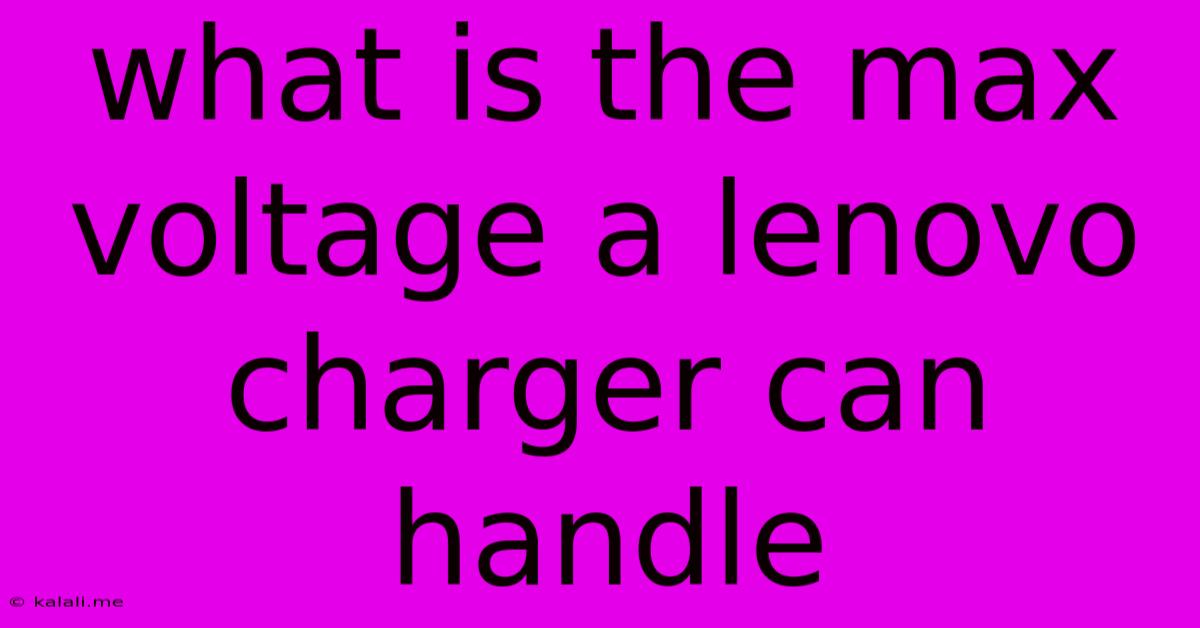What Is The Max Voltage A Lenovo Charger Can Handle
Kalali
Jun 11, 2025 · 3 min read

Table of Contents
What's the Maximum Voltage a Lenovo Charger Can Handle? Understanding Your Laptop's Power Needs
Finding out the maximum voltage your Lenovo charger can handle is crucial for ensuring the safety and longevity of your laptop. Using an incompatible charger can lead to damage, potentially rendering your device unusable. This article will guide you through understanding your Lenovo charger's voltage requirements and what happens if you use the wrong one.
Understanding Voltage and Its Importance
Voltage is the electrical potential difference that pushes electrons through a circuit. Your Lenovo laptop's power adapter (charger) converts AC power from your wall outlet into the DC power your laptop needs. The voltage printed on your charger indicates the output voltage, the voltage it provides to your laptop. This is different from the input voltage, which is the voltage drawn from your wall outlet (typically 100-240V AC).
There's no single "maximum voltage" applicable to all Lenovo chargers. Each Lenovo laptop model, and even different versions within the same model line, may have different power requirements. The crucial piece of information is not a maximum voltage, but the rated voltage. This is the voltage specifically designed for your Lenovo laptop model. Using a charger with a different output voltage can seriously damage your laptop's components.
Finding Your Lenovo Charger's Rated Voltage
The rated voltage is clearly printed on the charger itself. Look for labels or markings that indicate:
- Output Voltage (V): This is the most important number. It will typically be a value like 20V, 19.5V, or similar.
- Output Amperage (A): This indicates the current the charger can supply. While not directly related to the voltage limit, using a charger with insufficient amperage can result in slower charging or prevent charging altogether.
- Input Voltage (V): This shows the range of input voltages your charger accepts from your wall outlet (e.g., 100-240V).
What Happens if You Use the Wrong Voltage?
Using a charger with a significantly higher output voltage than your Lenovo laptop's rated voltage is extremely dangerous. It can lead to:
- Overvoltage: This can cause immediate and irreversible damage to your laptop's motherboard, other internal components, and potentially start a fire.
- Component Failure: Overvoltage can fry sensitive electronics within your laptop, rendering it unusable.
- Safety Hazard: A damaged charger or overstressed components could pose a fire risk.
Using a charger with a lower output voltage might result in:
- Slow or No Charging: The laptop may not charge at all or charge incredibly slowly.
- Inconsistent Performance: The laptop might experience unexpected shutdowns or instability.
Best Practices:
- Always use the charger that came with your Lenovo laptop. This ensures the correct voltage and amperage for optimal performance and safety.
- If your original charger is damaged, replace it with a certified Lenovo replacement charger or a charger with the exact same output voltage and amperage specifications. Don't experiment with chargers from other brands or models unless you are absolutely certain they are compatible.
- Check the specifications printed on both your laptop and the charger carefully before connecting them.
In Conclusion: There isn't a universal maximum voltage for Lenovo chargers. Instead, focus on using the charger with the output voltage precisely matching your laptop's requirements. Prioritizing safety and using the correct charger will guarantee the health and longevity of your Lenovo device.
Latest Posts
Latest Posts
-
Who Is Commonly Considered The Father Of Behaviorism
Jun 12, 2025
-
The Sum 3 Of Consecutive Even Numbers Is 125
Jun 12, 2025
-
Parts Of Digital Single Lens Reflex Camera
Jun 12, 2025
-
How Many Players On A Basketball Team On The Court
Jun 12, 2025
-
How Do You Find The Perimeter Of A Cube
Jun 12, 2025
Related Post
Thank you for visiting our website which covers about What Is The Max Voltage A Lenovo Charger Can Handle . We hope the information provided has been useful to you. Feel free to contact us if you have any questions or need further assistance. See you next time and don't miss to bookmark.